Litóhoro, Pieria, Greece, Saturday afternoon, 14 October 2000
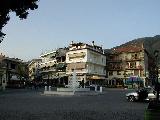
 We have taken a few short sightseeing trips since my last entry, taking advantage again of Paul and Joann's rental car, but mostly we have stayed here in Litóhoro, keeping house and school and getting some work done. We are getting to know the place better and better. Two of the town's better-known sights are the central Platía Elefthería (left, roughly translatable "Freedom Square" except for the shape), and adjacent to it the belfry and church of St. Nikolas (right).
We have taken a few short sightseeing trips since my last entry, taking advantage again of Paul and Joann's rental car, but mostly we have stayed here in Litóhoro, keeping house and school and getting some work done. We are getting to know the place better and better. Two of the town's better-known sights are the central Platía Elefthería (left, roughly translatable "Freedom Square" except for the shape), and adjacent to it the belfry and church of St. Nikolas (right).
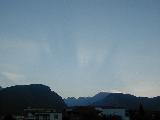
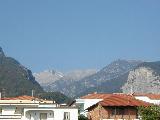 We also continue to observe the great variety of appearances that Mount Olympus assumes, even considering just those times when the higher peaks are clearly visible. (Usually the mountain does a good job of shrouding itself in either cloud or afternoon haze.) At left, you can see it surmounted with a radiating crown of light after the evening sun has gone behind it. After a very solid week of rain the high peaks emerged with a fair amount of snow on them, but by the time I had taken the camera to a good vantage, they were obscured by cloud; and by the next time I got a clear shot much of the snow had gone (right). I dare say there will be plenty of chances later on to catch it with plenty of snow.
We also continue to observe the great variety of appearances that Mount Olympus assumes, even considering just those times when the higher peaks are clearly visible. (Usually the mountain does a good job of shrouding itself in either cloud or afternoon haze.) At left, you can see it surmounted with a radiating crown of light after the evening sun has gone behind it. After a very solid week of rain the high peaks emerged with a fair amount of snow on them, but by the time I had taken the camera to a good vantage, they were obscured by cloud; and by the next time I got a clear shot much of the snow had gone (right). I dare say there will be plenty of chances later on to catch it with plenty of snow.
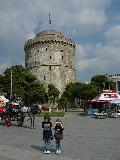 On September 27 (during the two weeks plus when Paul and Joann were gone to Turkey), we took buses to Thessaloníki. At left you see the town's best-known sight, the "White Tower," a fifteenth-century Venetian or possibly Turkish structure towering above the seafront esplanade. We also visited the archaeological museum there. The collection of "The Gold of Macedon" was particularly impressive, especially the Dervéni krater, a great metal urn with exuberant relief sculpture all over it depicting mythological scenes and persons, notably the sacred marriage of Ariadne and Dionysus. It is bronze, but golden in color thanks to extra tin in the alloy--there is no gold in it. There were also a number of fantastically wrought gold floral wreaths, imitating myrtle or laurel or oak foliage in paper-thin gold. The workmanship and state of preservation of these was impressive, but they struck me as vain evasions of the profound truth encoded in the very impermanence of the leafy wreaths they imitated: sic transit gloria mundi. (In the last line of "To an Athlete Dying Young," Housman refers to the classical victory-wreath as "the garland briefer than a girl's.") Some of the more famous pieces associated with this museum, including the golden box in which the bones of Philip II had been interred, turned out to have been repatriated to where they had been found, at Veryína. The collection of artifacts in clay and stone was less impressive; the Macedonian workers in these materials seemed to have been less inspired than their predecessors further south. On the way back to Litóhoro, we discovered that return bus tickets were not sufficient to secure passage--one had also to reserve seating on a specific run. This mistake cost us an hour on the return trip.
On September 27 (during the two weeks plus when Paul and Joann were gone to Turkey), we took buses to Thessaloníki. At left you see the town's best-known sight, the "White Tower," a fifteenth-century Venetian or possibly Turkish structure towering above the seafront esplanade. We also visited the archaeological museum there. The collection of "The Gold of Macedon" was particularly impressive, especially the Dervéni krater, a great metal urn with exuberant relief sculpture all over it depicting mythological scenes and persons, notably the sacred marriage of Ariadne and Dionysus. It is bronze, but golden in color thanks to extra tin in the alloy--there is no gold in it. There were also a number of fantastically wrought gold floral wreaths, imitating myrtle or laurel or oak foliage in paper-thin gold. The workmanship and state of preservation of these was impressive, but they struck me as vain evasions of the profound truth encoded in the very impermanence of the leafy wreaths they imitated: sic transit gloria mundi. (In the last line of "To an Athlete Dying Young," Housman refers to the classical victory-wreath as "the garland briefer than a girl's.") Some of the more famous pieces associated with this museum, including the golden box in which the bones of Philip II had been interred, turned out to have been repatriated to where they had been found, at Veryína. The collection of artifacts in clay and stone was less impressive; the Macedonian workers in these materials seemed to have been less inspired than their predecessors further south. On the way back to Litóhoro, we discovered that return bus tickets were not sufficient to secure passage--one had also to reserve seating on a specific run. This mistake cost us an hour on the return trip.
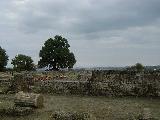
 Last Tuesday, after Paul and Joann had returned from Turkey, we all went to Veryína. Excavations here have allowed it to be positively identified with ancient Aegae, the old capital of Macedonia, which continued to be used for royal burials in the era of Philip II and Alexander the Great, by which time Pella served as capital. After some difficulty we found the "Great Tumulus," an artificial mound first built to obscure the tombs beneath, then excavated in modern times, and finally piled up again over what is now a subterranean museum, and quite a remarkable one at that, containing both the original tombs in situ and many of the treasures retrieved from them, all together in one large subterranean room. (I brought back no photos from underground, since photography is not permitted.) One of the tombs is quite clearly that of Philip II, Alexander's father and Demosthenes' bête noire, who established hegemony over most of Greece in the fourth century B.C. Another is somewhat less solidly identified as that of Alexander's and Roxane's son, also named Alexander, assassinated at the age of thirteen by the usurper Kassander. Yet another tomb, though quite obscure in terms of who was buried there, contains some of the best samples ever recovered of classical-era painting; but alas only full-size reproductions are visible, as entry into the tomb is not permitted. Afterwards, we went up the road to the palace (left), dating from the third century A.D. Its elevated seat commands a large prospect over the countryside, across a roadway now lined with column drums and other archaeological scrap (right).
Last Tuesday, after Paul and Joann had returned from Turkey, we all went to Veryína. Excavations here have allowed it to be positively identified with ancient Aegae, the old capital of Macedonia, which continued to be used for royal burials in the era of Philip II and Alexander the Great, by which time Pella served as capital. After some difficulty we found the "Great Tumulus," an artificial mound first built to obscure the tombs beneath, then excavated in modern times, and finally piled up again over what is now a subterranean museum, and quite a remarkable one at that, containing both the original tombs in situ and many of the treasures retrieved from them, all together in one large subterranean room. (I brought back no photos from underground, since photography is not permitted.) One of the tombs is quite clearly that of Philip II, Alexander's father and Demosthenes' bête noire, who established hegemony over most of Greece in the fourth century B.C. Another is somewhat less solidly identified as that of Alexander's and Roxane's son, also named Alexander, assassinated at the age of thirteen by the usurper Kassander. Yet another tomb, though quite obscure in terms of who was buried there, contains some of the best samples ever recovered of classical-era painting; but alas only full-size reproductions are visible, as entry into the tomb is not permitted. Afterwards, we went up the road to the palace (left), dating from the third century A.D. Its elevated seat commands a large prospect over the countryside, across a roadway now lined with column drums and other archaeological scrap (right).

 Just below the palace is the theater where Philip II was assassinated. The scant surviving stonework is of the same period, more or less, as the palace above, long after Philip's time; but the site is presumably the same as the much earlier theater. Re-using the old site would make sense, as saving a lot of unnecessary earth-moving for any new theater. Around the theater were olive trees with ripe fruit (right). could not resist sampling one, carefully paring off bits of the flesh beneath the skin. It was quite horrible--not immediately, but soon enough an acrid savor settled at the back of the throat and would not leave. I salute whatever prehistoric and nameless genius first had the faith and wit to realize the hidden gastronomic potential of this unprepossessing fruit. Mythology suggest that it took the goddess Athena to clue in the Athenians on that one.
Just below the palace is the theater where Philip II was assassinated. The scant surviving stonework is of the same period, more or less, as the palace above, long after Philip's time; but the site is presumably the same as the much earlier theater. Re-using the old site would make sense, as saving a lot of unnecessary earth-moving for any new theater. Around the theater were olive trees with ripe fruit (right). could not resist sampling one, carefully paring off bits of the flesh beneath the skin. It was quite horrible--not immediately, but soon enough an acrid savor settled at the back of the throat and would not leave. I salute whatever prehistoric and nameless genius first had the faith and wit to realize the hidden gastronomic potential of this unprepossessing fruit. Mythology suggest that it took the goddess Athena to clue in the Athenians on that one.
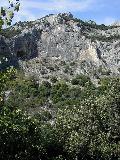

 On Wednesday we went to Lárisa, the principal town of Thessaly. The archaeological museum there turned out to be closed for repairs, and otherwise the city was not especially interesting, though it had a fine park with an extensive playground that the children enjoyed, plus a square with the fountain seen at left. The road there and back had more to recommend it, including the towering cave-pocked cliffs of the vale of Tempe (far left, where as already noted Goethe set part of Faust Part II), and an early thirteenth-century crusaders' castle at Platamónas (right).
On Wednesday we went to Lárisa, the principal town of Thessaly. The archaeological museum there turned out to be closed for repairs, and otherwise the city was not especially interesting, though it had a fine park with an extensive playground that the children enjoyed, plus a square with the fountain seen at left. The road there and back had more to recommend it, including the towering cave-pocked cliffs of the vale of Tempe (far left, where as already noted Goethe set part of Faust Part II), and an early thirteenth-century crusaders' castle at Platamónas (right).
Thursday we had planned to go to Pella, but a guidebook told us that both the site and the museum were to close at three, and it seemed a bit late to start. We resolved to go the following day. Meantime we went back to Dion, and this time visited the archaeological museum there, where the grave goods and other pottery and statuary from the site are kept and displayed. The most unusual object there is a set of fragmentary remains of a hydraulic pipe organ, in bronze, dating from the first century B.C. On the way back, we drove partway up Mount Olympus, along the gorge of the Enipeus, Litóhoro's stream. No real prospects were visible from the high spot where we turned around, as there was cloud beneath us; while above us, into the sun, were just some modern structures including radio facilities.
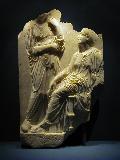
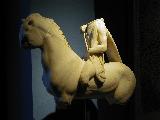
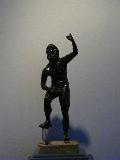 When we did get to Pella on Friday we discovered our guidebook had been wrong, as both the site and the museum were open till seven. The museum collection was small and very fine. I think my very favorite piece there was the grave stele far left, dating from the late fourth century B.C. Also shown here are the remains of a slightly later equestrian statuette, and a bronze figurine of Poseidon, with his left arm poised to hold the now-vanished trident--a late Hellenistic copy of work by Lysippus.
When we did get to Pella on Friday we discovered our guidebook had been wrong, as both the site and the museum were open till seven. The museum collection was small and very fine. I think my very favorite piece there was the grave stele far left, dating from the late fourth century B.C. Also shown here are the remains of a slightly later equestrian statuette, and a bronze figurine of Poseidon, with his left arm poised to hold the now-vanished trident--a late Hellenistic copy of work by Lysippus.

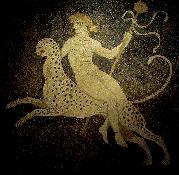 Most spectacular of the Pella finds are the pebble mosaics, dating from the last quarter of the 4th century B.C., right after the death of Alexander. On the left is a lion-hunt scene that may be based on a statuary group; on the right, Dionysus riding a panther and carrying a thyrsis.
Most spectacular of the Pella finds are the pebble mosaics, dating from the last quarter of the 4th century B.C., right after the death of Alexander. On the left is a lion-hunt scene that may be based on a statuary group; on the right, Dionysus riding a panther and carrying a thyrsis.
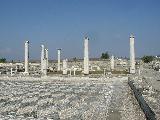
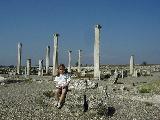
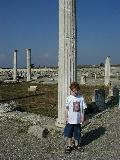 Several mosaics have been left in situ, including some pictorial ones as well as the geometric floor inlay shown far left. These photos all three show a partially restored Ionic peristyle surrounding the inner courtyard of a house from the late 4th century B.C.
Several mosaics have been left in situ, including some pictorial ones as well as the geometric floor inlay shown far left. These photos all three show a partially restored Ionic peristyle surrounding the inner courtyard of a house from the late 4th century B.C.
previous entry
next entry
main/ToC page

 We also continue to observe the great variety of appearances that Mount Olympus assumes, even considering just those times when the higher peaks are clearly visible. (Usually the mountain does a good job of shrouding itself in either cloud or afternoon haze.) At left, you can see it surmounted with a radiating crown of light after the evening sun has gone behind it. After a very solid week of rain the high peaks emerged with a fair amount of snow on them, but by the time I had taken the camera to a good vantage, they were obscured by cloud; and by the next time I got a clear shot much of the snow had gone (right). I dare say there will be plenty of chances later on to catch it with plenty of snow.
We also continue to observe the great variety of appearances that Mount Olympus assumes, even considering just those times when the higher peaks are clearly visible. (Usually the mountain does a good job of shrouding itself in either cloud or afternoon haze.) At left, you can see it surmounted with a radiating crown of light after the evening sun has gone behind it. After a very solid week of rain the high peaks emerged with a fair amount of snow on them, but by the time I had taken the camera to a good vantage, they were obscured by cloud; and by the next time I got a clear shot much of the snow had gone (right). I dare say there will be plenty of chances later on to catch it with plenty of snow.

 We have taken a few short sightseeing trips since my last entry, taking advantage again of Paul and Joann's rental car, but mostly we have stayed here in Litóhoro, keeping house and school and getting some work done. We are getting to know the place better and better. Two of the town's better-known sights are the central Platía Elefthería (left, roughly translatable "Freedom Square" except for the shape), and adjacent to it the belfry and church of St. Nikolas (right).
We have taken a few short sightseeing trips since my last entry, taking advantage again of Paul and Joann's rental car, but mostly we have stayed here in Litóhoro, keeping house and school and getting some work done. We are getting to know the place better and better. Two of the town's better-known sights are the central Platía Elefthería (left, roughly translatable "Freedom Square" except for the shape), and adjacent to it the belfry and church of St. Nikolas (right).















